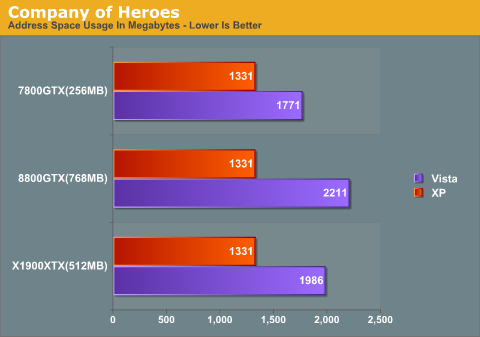A Messy Transition (Part 2): Windows XP, Vista, and the 2GB Barrier
by Ryan Smith on July 19, 2007 12:00 PM EST- Posted in
- Software
A Second Opinion
To answer the question of the source, we took two other games that have been known to encounter problems with the 2GB barrier: S.T.A.L.K.E.R: Shadow of Chernobyl and Company of Heroes. Both of these games as we found out in part 1 are currently shipping as large address aware, making them ideal candidates for examining address space usage under heavy load.
For STALKER, we are measuring address space usage around the particularly hectic and graphics-heavy starting camp. Usage was measured right after STALKER finished loading a saved game at that location.

Once again we are seeing two patterns as with Supreme Commander: under XP it's consuming far less address space than under Vista, and the amount of space consumed under Vista is dependent on the amount of video memory. On our bulky 8800GTX the difference between XP and Vista is 600MB, now 30% of our total 2GB of default address space. While STALKER manages to stay under 2GB, we could easily see the game cracking that. As for the relationship between video memory and address space used, it's less pronounced here, switching out for the 7800GTX only shaves off about 100MB.
Switching back once again to real-time strategy games we have Company of Heroes. Here we're checking address space usage at the start of the single-player Cherbourg mission, which as one of the visually richest levels in the game has the greatest capacity for hitting the 2GB barrier and reportedly has been causing problems doing so.

If we were handing out prizes for the biggest difference in address space usage, Company of Heroes would take the cake. At 2.16GB with our 8800GTX on Vista versus 1.30GB on XP, the increase in address space usage is now over 40% of the default and had we not modified our memory allocations Company of Heroes would have crashed. We also see our clearest pattern here of a difference in address space usage based on video memory, under Vista the address space usage with our 7800GTX is some 430MB less.










57 Comments
View All Comments
chalk - Thursday, July 19, 2007 - link
It might be interesting to perform a test using Vista Home Basic, to see if the "overhead" inherent in the Aero GUI is a penalty in terms of memory use. My impression of the recent incarnations of Apple's GUI i.e. OS-X is that there is quite a penalty in terms of system resources as compared to the Windows XP GUI. It was with some pessimism that I saw Microsoft once again "emulating" Apple, as it produced a new GUI that is "real purdy" but uses appreciably more system resources. I would choose a "lean" interface that allows me to work (and a game might be considered work) more efficiently, that is, allocate computer resources to the work at hand as opposed to a glossy visual interface. I am not as technically adept as many or most of the Anandtech readers, so excuse me if my post is misguided. thanks.EndPCNoise - Friday, July 20, 2007 - link
I believe the Aero GUI (Graphic User Interface) can be switched off, and Vista can be run in a more "basic" GUI - less of a resource hog.I would also be interested if this makes any difference.
Sulphademus - Friday, July 20, 2007 - link
You can turn off the superdeeduper effects in Vista and scale it back to XP or even to 2K. Windows should cut off rendering such data in a full screen game... I would think. But an interesting test, especially for people like me who WoW in a maxized window (and run dual monitors). I know Warcraft isnt a "modern" game but, when you have 25+ people dancing around, it brought my former 7600GS to a halt. How much extra memory will Vista's purdy UI cause the OS to shadow from the video card's resources?Inquiring minds want to know!
leexgx - Thursday, July 19, 2007 - link
all these tests have been done under the 32 bit sides of windows what about 64 bitbrian26 - Thursday, July 19, 2007 - link
The title says it all, id like to see what kind of impact Vista x64 has on the same tests.Zorlac - Thursday, July 19, 2007 - link
I do not think it would have an effect if the app is 32bit. Vista 64 would only solve the problem with native 64bit apps....or maybe if the 32bit app has that large address flag or whatever.EndPCNoise - Friday, July 20, 2007 - link
I do not think it would have an effect if the app is 32bit. Vista 64 would only solve the problem with native 64bit apps....or maybe if the 32bit app has that large address flag or whatever.I believe you would be correct about this, but I would still like to see it tested.
Sulphademus - Friday, July 20, 2007 - link
Now in XP64, or Vista64, how would the 32bit code address space work?In x86 the /3g applies to the whole OS, but in x64 what does the 32bit app think it is running under? I assume that the code is meant to operate under 2g/2g but what is it actually given? Possibly a full 32bits worth of 4g?
What happens under Vista x64 with 4 or more gigs of ram when youre running Supreme Commander and push the apps VM to 2.5, 3, or 3.5 GB? Repeat with an app that is /3g aware?
xiaowugui - Thursday, July 19, 2007 - link
The DX10 specification has that whole virtualization thing, and I heard that the R600 actually fully support it. I wonder if that will make vista happier in its memory management for games?BUL - Thursday, July 19, 2007 - link
...the ever-growing Trapper Keeper from "South Park".